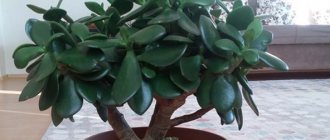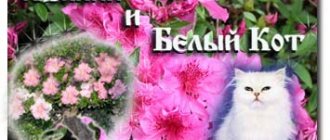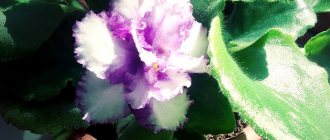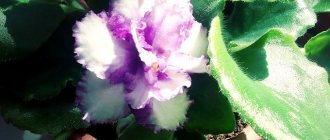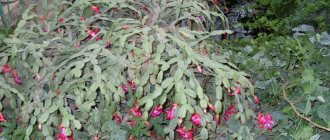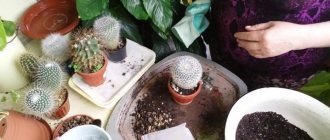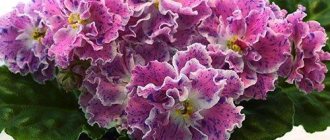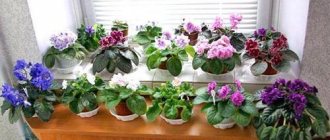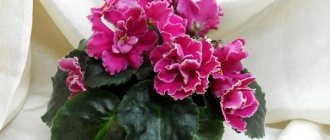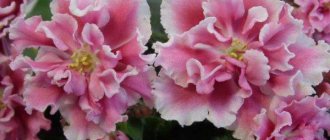- Reports
- Plants
- Violet
The violet is distinguished by its delicate and modest beauty. Many legends and tales have been invented about her. In Ancient Greece, for many years they prepared a healing spring drink from violet flowers, and infused the plant with strong wine. On the day of the spring holiday, the Greeks brought bouquets of violets to their homes and decorated them with statues of gods and their children who had reached the age of three. This custom personified the entry into life of future citizens of a great state.
In southern Germany, in the Middle Ages, a spring holiday was also celebrated, which was associated with the appearance of violets. The Germans believed that the young man who found the first violet would become the husband of the most beautiful and richest girl in the country. This holiday was celebrated with fun games, songs and dances. Among the Slavs, tricolor violet was popular not only as a beautiful plant, but also as an excellent healing agent.
Violet is found most often in countries with temperate climates. It can be seen in meadows, pastures, along the edges of fields, and on coniferous forest lawns. Depending on the species, violet can be an annual or perennial herbaceous or shrubby plant. It blooms five months a year, starting in April. Many gardeners grow violets in their garden plots and cottages. The plant is often called pansy.
The tricolor violet is especially popular; it is popularly called Ivan-da-Marya, brother and sister, half-color. This is an annual or biennial plant. The bare or pubescent stem of the plant reaches 20 centimeters. Flowers with irregular tricolor petals are located at the top of the stem. Violet begins to bloom in late May - early June. The ripe fruit of a plant is a seed capsule. The shiny, light brown or yellow seeds remain viable for two years.
Tricolor violet is used in folk and scientific medicine as a good remedy for many diseases. In Rus', since ancient times, flowers, leaves and stems of not only tricolor violets, but also field violets have been used. The main substances (vitamin C, essential oil, flavonoids, ascorbic and salicylic acid) help against scrofula, toothache, bronchitis and pneumonia. Infusions and teas are prepared from it. Violet is good to use for skin diseases: eczema, wounds, ulcers, boils, for the treatment of scrofula. The crushed herb is used to treat lichen. Violet can be purchased in pharmacies in the form of powders, extracts and various syrups. But using tricolor violet preparations without a doctor’s prescription can lead to an overdose, and therefore harm your health.
Growing violets
To prepare a report on violets in grade 2, it is not enough for schoolchildren to simply describe the plant . It is important to study its origin, growth characteristics and properties.
Garden violets have many qualities that make them attractive to grow. It is beautiful and sophisticated, very noticeable, despite its miniature size, easy to care for and blooms for a long time. Even novice gardeners can grow it even at home. It can be annual or perennial.
Violets originate from East Africa. In countries with a predominant temperate climate and subtropics (America, Australia and New Zealand) there are about 500 species of wild violets. In our country there are several hundred hybrids of the Violet family.
Many come from the pansy, or tricolor violet, a plant called the great-grandmother of modern hybrids.
Flower care
The plant prefers sunny places, but thrives in partial shade. The main requirement is fertile soil, loose with good drainage. Stagnation of water is detrimental to it. When planting, you should not plant flowers too close to each other; be sure to leave at least 10-15 cm between the bushes to avoid the risk of rotting of the roots.
Reproduction technology
The plant can be replanted from place to place at any time during the warm season. This will only have a beneficial effect on the development of the root system .
All types of violets can reproduce in several ways:
- seeds;
- cuttings;
- self-seeding.
The seeds are grown to produce an annual plant that will bloom in early summer. Seedlings are sown in February, and in May they are transplanted to a permanent place.
Cuttings are suitable for all types of viola. It is held in the summer, from May to the end of July. The cutting is the top of a green shoot, which must have at least 2-3 nodes. Fold it into soaked paper and dig it about 5 cm into the ground. It is advisable to choose a partial shade location for planting. It is important to remember that if you root at the very beginning of summer (May), they will bloom in the first year. If you take cuttings later (June, July), you will get a biennial plant, and it will bloom only in the second year.
Self-seeding is the easiest type of propagation. The gardener only needs to plant the sprouted seeds in early spring in a chosen location; using this method, a biennial plant is obtained.
Houseplants. Violet is our friend.
Author: Lidiya Aleksandrovna Turganova
Educational institution: Structural unit of MAOU "Secondary School No. 132" named after. N.M. Malakhov “Kindergarten No. 259”
Location: Barnaul, Altai Territory
Topic: Summary of GCD caring for violets “Indoor plants. Violet is our friend" for children of the middle group.
Library Section: Lesson Developments
Publication date: 12.04.2019
Goal: To develop children’s labor skills in caring for indoor plants.
Tasks:
1. Encourage children's interest in indoor plants
2. Activation of vocabulary on this topic: care for, water, spray, loosen, leaves, stem, flower, root.
3. Cultivate a love for indoor plants, see their beauty and benefits.
Materials and equipment: brushes for processing leaves, watering cans, a spray bottle, sticks for loosening the soil, violet flowers, a letter from Dunno, aprons for work, pictures of indoor plants.
Progress of the lesson:
I’m asking a riddle: They purify the air, create comfort.
They turn green on the windows and bloom all year round.
(Children's answers)
- That's right, these are indoor plants. They surround us in kindergarten and probably everyone has them at home. Now we will find out what plants you know. (I show pictures - children name houseplants)
- Do you think these plants live in our group? (Children's answers)
(I suggest playing the game “Find a Flower”. I hand out pictures to the children, they find flowers in the group).
— Guys, why do we need indoor plants? (Answers: for beauty, release oxygen, etc.)
— To make plants beautiful, we take care of them. Let's remember how we care for our flowers. (I show cards of the scheme: watering flowers, loosening, wiping leaves, spraying leaves). I ask questions about the cards:
- Why do we water flowers?
— Why do we loosen the earth?
— Why do we spray the leaves?
- Why do we wipe the leaves?
- What do you think this card tells us? (There is a sun drawn on the card). (Children's answers: flowers love light and warmth).
- That's right, about flowers that love light and warmth, we can say that they are light-loving.
— When we properly care for flowers, they grow beautiful and give us
joy.
Physical exercise “Flowers”. (Children turn into flowers)
Our scarlet flowers open their petals,
The breeze breathes a little - the petals sway.
Our scarlet flowers cover their petals,
They shake their heads and quietly fall asleep. (They turn back into children).
- Guys, I completely forgot, when I was going to kindergarten, I met the postman. He gave me a letter for you. Let's read the letter. (Dunno writes that he was given a flower. He doesn’t know how to care for it. He asks for help. I show him a photo of the flower.)
- What is the name of the flower? (Violet)
— Does violet grow in our group? (Yes)
— Several varieties of violets grow in our group. Let's go up to them and look at them. (children approach the violets, look at them, and I accompany them with a description).
— Violet “Magic of Love” is a densely double star-shaped flowers, shaped more like a pom-pom. The color of the flowers is deep burgundy, with a beetroot tint. There is an elegant white edging along the edge of the petals. The leaf rosette is smooth, beautiful green in color.
Violet "Wind Rose"
The flowers of the Wind Rose violet are very reminiscent of garden roses. The petals have a pale pink tint. Toward the curled fringed edges, the color thickens and becomes a thin crimson, and in places a green border. The rosette is composed of wavy light green leaves.
Violet "Le Macho"
The corollas of the “Le Macho” violet have a pronounced star shape and are colored in a thick burgundy-violet color. The wavy edge of the petals is set off by a contrasting white border. The leaves are simple, ovoid, medium green in color.
Violet "Sea Wolf"
Against the background of large dark green foliage, united in a rosette of the Sea Wolf violet, the giant blue flowers of the variety, up to 8 cm in diameter, stand out perfectly. The corollas are semi-double and bell-shaped. The petals are wavy, with a reticulate pattern, noticeable at the full flowering stage.
- What parts do they consist of? (Leaves, root, flower)
— What color are the leaves?
-What shape are they?
-What are the largest leaves?
- What do they feel like? (I suggest you touch it - velvet, with fluff)
— Do you think it’s possible to wipe them with a cloth? (No)
- Why? (Children's answers).
— To remove dust from violet leaves, you can use a brush. (I show and explain, I spray the leaves).
- Guys, I suggest you also work with brushes and take care of the violets. (Children do the work).
— Violets don’t like a lot of sun; they get burned from the sun’s rays. It is inconvenient to water the violet, it does not have a stem, the leaves cover the soil in the pot and if water gets on the plant, it rots and may die. Guys, what do you think, how can you water a violet without harming it? (Children's assumptions).
- Water the violet in a tray (I show and explain, remember - this is one of the ways to water flowers.)
- Guys, we helped Dunno today, well done!
- What new did you learn?
- What have you learned?
— We remembered how to care for flowers. Let's play. Well done! Reward: stickers with flowers.
Interesting Facts
Few people know that the popular flower has found its use in cooking. In addition, it has long been used in traditional and folk medicine.
Use in cooking
The low calorie content of dishes using the plant allows you to enjoy the unusual taste and will help you maintain your figure. Candied spiced flower petals, packed in boxes with the image of Empress Elisabeth of Bavaria, are a flower dessert that is a souvenir calling card of the capital of Austria - Vienna.
There are unusual dishes with flowers of a beautiful plant: pastries, drinks, desserts. The most common:
- violet cake;
- dessert “violet tenderness”;
- violet cocktail;
- Everyone's favorite treat is ice cream.
Application in medicine
Information about the medicinal properties of violets has been known since ancient times. Some parts of the plant are classified as medicinal, especially the roots and rhizomes, and have been used in medicine since ancient times. When included in the diet, violet gives a high healing effect, since it contains micro- and macroelements that are vital for the human body:
- manganese;
- glycosides;
- iron;
- calcium;
- magnesium;
- vegetable acids;
- saponin;
- inulin;
- violin.
The healing properties of the plant have been proven: antispasmodic, choleretic, antiseptic. In pharmaceuticals, violet is used as part of breast herbal teas to soften and thin the mucus in dry coughs and colds.
The aroma of flowers does not cause any allergic reactions. Perfumers widely use flower extracts to create perfumes and body oils. In addition to the wonderful aroma, such oils have a soothing effect on the skin and relieve irritation.
From the story about the violet for grade 2, children get acquainted not only with the botanical diversity and characteristics of plants, but also learn that they have not only decorative properties, but also medicinal and many others.
Interesting facts about violets
- The Greeks decorated the coffins and graves of dead people with violets, as they considered the violet to be the flower of death and sadness.
- Many writers and even kings loved violet.
- Violet not only decorates but also cleans the air.
- The flower releases volatile substances that have a very beneficial effect on the human body.
- With the help of violets, lands rich in zinc were discovered, since the largest flowers grow in soil with a large amount of zinc.
- In Rome, the violet was considered the flower of Jupiter.
- Perfume was made from violets; there is a town in Italy where perfume made according to ancient recipes is still sold to this day.
- China produced dresses with the scent of violet, the scent was persistent and lasted even after 5-7 washes.
How did Saintpaulias become indoor plants and appear in Russia?
Saintpaulia gained dizzying popularity in America at the beginning of the last century. There, societies of lovers of this flower began to be created, and breeders began to develop new varieties. The fashion for an unusual beauty quickly spread among citizens.
Americans, and later Europeans, decorated window sills and verandas with bright bushes. Firms that produced crop seeds became rich. Various magazines wrote about the characteristics and cultivation of this wonderful plant.
By the middle of the 20th century, information about Saintpaulia spread throughout the world. Violets, which effectively decorate interiors, turned out to be easy to grow and responsive to care.
In our country, the popularity of Saintpaulia began in the 60-70s of the last century . At first, plants could only be seen in botanical gardens. But after several materials about Saintpaulias were published in magazines, housewives are beginning to grow unpretentious bushes on windowsills.
Popular messages and reports today
In the modern world, the Olympic Games are held every 4 years, with winter and summer games alternating every 2 years. Our society, like Ancient Greece, can boast of Olympic champions
The Far Eastern leopard (or Amur leopard) is an endangered representative of the cat family, listed in the International Red Book. The predatory mammal is the rarest subspecies of leo
Gemini belongs to the zodiac constellations. They are located in the sky of the northern hemisphere, north of the constellation Orion. Its neighbors are Taurus, Unicorn, Lynx and Small Dog. Gemini can be
Chimera violets
Chimera violets are considered the most unusual, imaginative and expensive - the result of the painstaking work of experienced breeders. Experts obtain the variety experimentally, repeatedly crossing and planting up to 1 thousand specimens, and then selecting flowers that fit the description of chimeras.
The chimera is easily recognized by its beautifully patterned petals. The abundance of colors is simply mesmerizing. Such exclusive plants are not propagated vegetatively, since subsequent generations completely lose the characteristics of the variety.
In addition, chimeras are characterized by increased susceptibility to various diseases and pests. Such varieties require increased attention and careful care. Although in order to admire such beauty, you should follow all the rules for growing them. Exclusive homemade chimera violets are a real treasure for collectors.
Today, breeders are working on the aroma of indoor violets, since their wild relatives, unfortunately, do not emit virtually any odor.
Poems about violets for children: 14 best
Website “Mom can do anything!” I collected the most beautiful poems about violets for children. The violet is perhaps the most common house flower. There are many poems and riddles about the violet. We have chosen for you the shortest poems that will be easy to learn even with the smallest children.
***
A lilac bouquet of surprised violets Looks like a lilac sunset. Like a sunset, it shines wearily and a gentle aroma flows.
***
Where is the violet, my flower? Last spring Here the stream watered her with a fresh stream?.. She is not here; spring has passed, and the violet has bloomed.
***
Winter snowstorms The sun drove away. A fragile violet stood up in the middle of the forest.
***
The violet shed its scent in the air, And the wolf acted evilly among the grazing people; He was bloodthirsty, the violet was sweet: Everyone follows his nature.
Author: Pushkin A.
***
I hold a violet in my hand, I remember the past: I feel sorry for the past, don’t I feel sorry? Was it worse or better?
Conversations and smiles Without questions and answers... And the last attempts not to follow advice...
I smile at the flower, at this little violet, I need to put an end to it, so that I don’t feel sorry for it at all.
***
Again the violet on the window gave us its bouquet. Like a generous violet, I bloom in the world for you.
I only ask: cover me with your Hand, pour water of forgiveness. I can’t survive the snow and heat, After all, I am a house plant.
Author: Kovrizhnykh S.
***
Isn't the violet beautiful? Doesn't it seduce you? Doesn't it breathe ambrosia in the morning, blooming in the spring?
This flower turns red and then turns pale on a red day, pouring out its sweet spirit, hiding in the grass under a bush.
What will happen to the tender violet, what will finally happen? Ah, the unfortunate thing languishes, It dries up and withers suddenly.
Author: Zhukovsky V.
***
The fragrant violet blossomed in spring with a delicate aroma and filled the whole forest.
***
Winter frosts The sun drove away. The fragile violet stood up in the clearing.
The blue corolla reaches out stubbornly towards the sun. I will pick the first violet for my mother.
Author: Pasnaleeva V.
***
Have you seen violets in the snow? Hot buds on white? They greeted spring joyfully. Alas, it did not warm their souls.
We are waiting for spring like the first flowers And we are pulling our hearts towards the sun and hope. But pain, the cold ghost of winter, will cover the soul in white clothes.
***
Her flowers are made of silk, Her leaves are made of velvet. She needs care only for greater beauty.
Author: Prilutsky S.
***
As soon as nature came to life, spring already gave purple violets from under the snow as a symbol of love and kindness.
The violet is modest and innocent, elegant in its beauty, and the smell is incomparable to anything, with green, juicy foliage.
Kept in a medallion all my life As a sign of tenderness and fidelity, No wonder we love Josephine And Napoleon - their magician!
Author: Tsvetova T.
***
At the sunny edge the violet blossomed and quietly raised her lilac ears.
She is buried in the grass from the raking hands. But someone will bow to her, And it’s immediately obvious: a friend.
Author: Serova E.
The history of violets in nature
Violet has another name - Saintpaulia . This is what leads to the secret of the opening of the flower. flowering plant with blue petals, bright yellow stamens in the center, and emerald leaves was found in Africa (a mountainous place called Uzambara) .
Uzambara violet in nature.
Saint-Paul , saw a beautiful bush . He was walking with his beloved woman when he came across a flower. The man was struck by the fact that the bush was located right on the stone, which was covered only by a small layer of moss. At the same time, the plant looked healthy and strong. The find greatly impressed the head of the colony, who had a curious disposition.
The governor sent a copy to his father in Europe. He, in turn, gave the seeds to scientists, who gave the plant the name Saintpaulia in honor of the governor of the colony.

